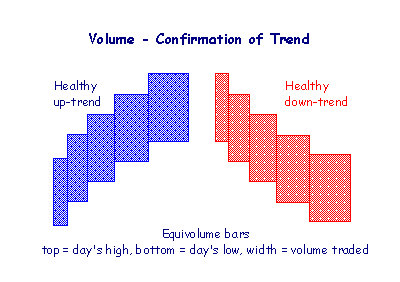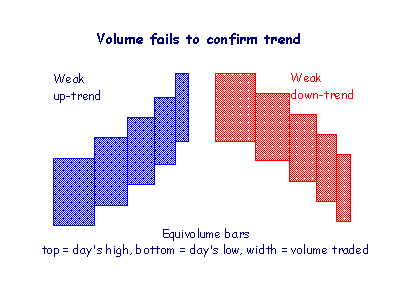Size of OI reflects intensity of markets and positions
OI up Prices up then buy (10)
Trading Signals
Short-term
Trend confirmation:
- Rising prices and rising volume signal a healthy up-trend.
- Falling prices and rising volume signal a healthy down-trend.

Trend weakness:
- Rising prices and falling volume signal trend weakness.
- Falling prices and falling volume may signal trend weakness. See Low
Volume in Down-trends for further details.

A large range with low volume indicates a lack of
interest from sellers (if price is rising) or buyers (if price is falling).
Long-term
Trend confirmation:
- Higher peaks with higher volume at peaks signal a healthy up-trend.
- Lower troughs with higher volume at troughs signal a healthy down-trend.
Trend weakness:
- Higher peaks with lower volume at peaks signal that the up-trend is
weakening.
- Lower troughs with lower volume at troughs signal that the down-trend is
weakening.
Accumulation and distribution indicate who is in control
of the market and often signal a reversal.
Trading
ranges represent longer term accumulation or distribution.
Accumulation is when the market is controlled
by buyers.
A down-trend that stalls while volume remains high signals that accumulation
is taking place. Sellers have lost control
to buyers and a reversal is likely.
An Accumulation Day occurs when either:
- Volume increases (compared to yesterday) and closing price moves higher,
or
- After trending downwards, there is little or no price movement and an
increase in volume.
Distribution is when the market iscontrolled
by sellers.
An up-trend that stalls while volume remains high is a sign that distribution
is taking place. Buyers have lost control
to sellers and a reversal is likely.
A Distribution Day occurs when either:
- Volume increases (compared to yesterday) and closing price moves lower, or
- After trending upwards, there is little or no price movement and an
increase in volume.
When price is trading in a range, volume may indicate in which direction a
breakout is most likely to occur:
- Higher volume at peaks means that an upward breakout is more likely
- Higher volume at troughs indicates that a downward breakout is more likely
Use volume to confirm the breakout:
- High volume indicates a healthy breakout.
- Low volume indicates weakness.
After a trend has lasted several months, there is often a surge in price and
volume, which may signal that the trend is about to expire. Look out for:
- Spikes
- Wide-ranging
days,
- Exhaustion
gaps, and/or
- Reversal
signals.
Low volumes do not necessarily signal the end of a down-trend. Commitment
from buyers is necessary to drive up prices. Prices can fall due to a lack of
interest from both buyers and sellers.

